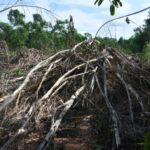Climate change is having profound effects on ecosystems across the globe. Rising temperatures and changing precipitation patterns are altering the delicate balance of these environments, leading to significant ecological disruptions. One of the major impacts is the loss of biodiversity, with many species struggling to adapt to the rapidly changing conditions. Ecosystems such as coral reefs, forests, and wetlands are particularly vulnerable, with increased risk of degradation and collapse. Climate change also disrupts crucial ecological processes, such as pollination and nutrient cycling, further compromising the resilience of ecosystems. Urgent action is needed to mitigate the impacts and protect these vital ecosystems for future generations.
Climate change has profound impacts on ecosystems worldwide, affecting biodiversity, species distribution, and ecological interactions. One critical consequence of climate change is the alteration of habitat suitability for numerous species. As temperatures increase, the geographic ranges of many plants and animals shift, often disrupting delicate ecological balances. Some species may adapt and migrate to more favorable environments, while others face extinction or reduced population sizes.
Another major impact of climate change on ecosystems is the disruption of mutualistic relationships. Many species rely on mutualistic interactions, such as pollination or seed dispersal, for their survival and reproduction. However, changes in temperature and precipitation patterns can lead to mismatches in timing between species. For example, if the flowering period of a plant shifts due to climate change, pollinators may not be available to facilitate pollination, leading to declines in plant populations.
In addition, climate change can influence species interactions by favoring some species over others. This can result in shifts in community structure, leading to changes in species composition and abundance. For instance, as temperatures rise, certain plant species may become more competitive, dominating ecosystems and outcompeting other species. This can have cascading effects on entire food webs, impacting higher trophic levels.
Climate change also affects the functioning and productivity of ecosystems. Changes in temperature and precipitation patterns can alter nutrient cycling, plant growth, and primary productivity. These changes can have far-reaching effects on ecosystem services, such as carbon storage, water purification, and the provision of food and resources for humans.
Overall, the impacts of climate change on ecosystems are vast and varied. From habitat shifts and species extinctions to disrupted interactions and altered ecosystem functioning, the consequences of climate change on ecosystems are of great concern. Addressing climate change and implementing sustainable practices is crucial to mitigate these impacts and preserve the integrity and resilience of Earth’s ecosystems.
Effects of climate change on biodiversity
Effects of climate change on biodiversity:
Climate change has major consequences on biodiversity, resulting in significant shifts in ecosystems worldwide. The following are some of the key effects of climate change on biodiversity:
1. Habitat loss and fragmentation: As global temperatures rise, many species are facing habitat loss due to changing climate conditions. Rising sea levels, increased droughts, and frequent wildfires contribute to the destruction and fragmentation of ecosystems. This loss of habitat disrupts ecosystems and makes it challenging for species to survive, leading to changes in species composition and diversity.
2. Range shifts and distribution patterns: Climate change forces many species to adapt and adjust their habitat ranges. Warmer temperatures may push species towards higher latitudes or higher elevations, while some may have to migrate to cooler habitats. These shifts in distribution patterns can lead to changes in interactions between species, including competition, predation, and mutualism.
3. Loss of biodiversity and species extinction: Climate change accelerates the rate of species extinction. As habitats become inhospitable or disappear altogether, many species find it difficult to survive. This loss of biodiversity disrupts entire ecosystems, as each species plays a crucial role in maintaining a balanced ecosystem. The extinction of keystone species, for instance, can have cascading effects on entire food webs and ecological processes.
4. Phenological shifts: Climate change also affects the timing of critical ecological events, such as breeding, migration, and flowering. Many species rely on precise environmental cues, such as temperature, day length, or rainfall, to initiate these events. However, due to altered climate patterns, these cues are becoming less reliable. Such phenological shifts can disrupt species interactions and lead to mismatches between predators and prey or pollinators and flowering plants.
5. Increased invasive species: Climate change provides favorable conditions for the establishment and spread of invasive species. Warmer temperatures, changes in precipitation patterns, and altered disturbance regimes enable invasive species to outcompete native species and occupy new habitats. These invasive species can negatively impact native biodiversity by altering ecosystem dynamics and displacing native species.
Overall, the effects of climate change on biodiversity are profound and complex. They not only result in the loss of individual species but also disrupt entire ecosystems and ecological processes. The conservation of biodiversity in the face of climate change requires comprehensive strategies that address habitat protection, restoration, and enhancing the resilience of species and ecosystems.
Impacts of climate change on forests
Impacts of climate change on forests:
Climate change poses significant challenges to the health and resilience of forests around the world. Rising temperatures, shifting precipitation patterns, and increasing frequency and intensity of extreme weather events are all impacting forest ecosystems in various ways. Here are some key impacts of climate change on forests:
1. Increased forest fires: Warmer and drier conditions, combined with prolonged periods of drought, have contributed to a rise in forest fires. These fires can cause extensive damage to forests, leading to the loss of tree species and entire ecosystems. Furthermore, the increased frequency and severity of fires can alter the natural regeneration processes and increase the risk of invasive species colonization.
2. Altered tree species composition: Climate change affects the distribution and growth of different tree species. As temperatures increase, certain species may become less suited to their current habitats, leading to shifts in their ranges. Some tree species may struggle to migrate and establish themselves in new areas, while others may outcompete native species in their current ranges. Such shifts in tree composition can disrupt forest ecosystems and impact the overall biodiversity.
3. Increased pest and disease outbreaks: Climate change can facilitate the proliferation of pests and diseases that target trees. Warmer winter temperatures and early spring conditions can favor the survival and expansion of many damaging insect pests, such as bark beetles. These pests can weaken and kill trees, leading to widespread forest die-offs. Additionally, warmer and wetter conditions can create a more favorable environment for the spread of tree diseases, further impacting forest health.
4. Changes in forest water availability: Alterations in precipitation patterns and the melting of mountain glaciers due to climate change can significantly affect the availability of water resources for forests. Changes in water availability can impact the growth and survival of trees, particularly in regions already facing water stress. Forests may become more susceptible to drought-induced mortality, reducing their ability to provide ecosystem services such as water purification and regulation.
5. Loss of carbon storage: Forests are crucial carbon sinks, absorbing and storing vast amounts of carbon dioxide from the atmosphere. However, climate change impacts on forests can disrupt this vital role. Increased disturbances such as fires and pests can release large amounts of stored carbon back into the atmosphere. Moreover, stressed and dying trees may uptake less carbon dioxide, reducing their potential to mitigate climate change through carbon sequestration.
It is essential to address the impacts of climate change on forests through proactive strategies such as forest management planning, reforestation programs, and the protection of vulnerable ecosystems. By taking action, we can support the long-term health and resilience of forests in the face of ongoing climate challenges.
Impacts of climate change on oceans
Impacts of climate change on oceans
Climate change has significant consequences for Earth’s oceans, causing substantial impacts on marine ecosystems. Rising temperatures, sea level rise, ocean acidification, and changing precipitation patterns all contribute to these impacts, which have severe implications for the health and biodiversity of our oceans.
One of the most apparent impacts of climate change on oceans is the rise in sea surface temperatures. As greenhouse gases trap heat in the atmosphere, the oceans absorb a considerable amount of this excess energy. This rise in temperature has profound effects on marine life, disrupting the delicate balance of ecosystems. For example, it can lead to coral bleaching events, where coral reefs expel their symbiotic algae due to stress from high temperatures. This not only affects the corals themselves but also the countless species that rely on them for food and shelter.
Additionally, climate change causes thermal expansion, leading to an increase in the volume of seawater. As a result, sea levels rise, posing threats to coastal communities and habitats. Low-lying areas, such as small islands and coastal marshes, face the risk of flooding and erosion, displacing people and wildlife. Moreover, the intrusion of saltwater into freshwater ecosystems can negatively impact coastal wetlands and estuaries, affecting their biodiversity and overall functioning.
Ocean acidification is another critical consequence of climate change. As carbon dioxide (CO2) is released into the atmosphere, a portion of it is absorbed by the oceans and reacts with seawater, forming carbonic acid. This acidification reduces the availability of carbonate ions, hindering the ability of marine organisms like corals, shellfish, and plankton to build and maintain their calcium carbonate skeletons or shells. This disruption cascades through the food web, impacting species at all trophic levels and ultimately threatening the productivity and resilience of marine ecosystems.
Furthermore, changing precipitation patterns affect ocean salinity and nutrient distribution. Excessive rainfall in some regions leads to increased freshwater runoff into coastal waters, reducing salinity levels. This freshwater influx can disrupt the balance of nutrients essential for the growth and survival of many marine species. Conversely, decreased precipitation and droughts in other regions intensify the concentration of salts, making the water more saline. Such alterations in salinity levels can impact the distribution and abundance of marine organisms, negatively affecting fisheries and the livelihoods of coastal communities.
In conclusion, climate change is profoundly impacting Earth’s oceans and the ecosystems they support. The rise in temperatures, sea level rise, ocean acidification, and changes in precipitation patterns are all contributing to a wide range of ecological disturbances. Coral bleaching, habitat loss, reduced biodiversity, and altered food webs are some of the significant consequences we observe. Recognizing the urgency of addressing climate change and implementing measures to mitigate its impacts on oceans is crucial for safeguarding marine ecosystems and securing a sustainable future for all.
Impacts of climate change on polar regions
Impacts of climate change on polar regions:
Climate change is having profound effects on polar regions, resulting in significant impacts on both the physical environment and the unique ecosystems that exist in these areas. From melting ice caps and glaciers to alterations in biodiversity, the ramifications of climate change on polar regions are alarming and require immediate attention.
One of the most obvious and devastating impacts of climate change in polar regions is the loss of ice. The Arctic, specifically, has experienced a substantial reduction in sea ice extent and thickness over the past few decades. This melt has serious consequences for various species that rely on the ice for survival, such as polar bears and seals. With the loss of their icy habitats, these animals struggle to find food and raise their young, leading to population declines and potential extinction threats.
Moreover, the melting of permafrost is another notable consequence of climate change in the polar regions. Permafrost is a layer of frozen soil, consisting of dead plants and trapped carbon. As temperatures rise, permafrost thaws, releasing significant amounts of carbon dioxide and methane into the atmosphere. These greenhouse gases contribute to global warming, creating a dangerous feedback loop that exacerbates climate change further.
The altered climate in polar regions also affects the delicate balance of marine ecosystems. As the water warms, it leads to changes in ocean currents and nutrient distribution, ultimately impacting the food chain. Higher water temperatures have already resulted in shifts in fish distribution and migration patterns. These changes can disrupt the livelihoods of indigenous communities that rely on fishing for sustenance and economic stability.
Furthermore, the acidification of polar oceans due to increased carbon dioxide absorption is having detrimental effects on shell-forming organisms like plankton, krill, and various species of mollusks. These organisms serve as crucial food sources for larger marine animals, including whales and seabirds. The decline in their populations can have far-reaching consequences for the entire food web in the polar regions.
Lastly, climate change is altering the delicate balance of polar terrestrial ecosystems. As temperatures rise and ice melts, new plant species are colonizing previously barren areas. This change in vegetation can disrupt the habitats of native plants and animals that are adapted to the cold and harsh conditions of the polar regions.
In conclusion, the impacts of climate change on polar regions are multifaceted and alarming. The loss of ice, melting permafrost, altered marine ecosystems, and changing terrestrial ecosystems are all significant concerns. Addressing climate change and taking measures to mitigate its effects is crucial to protect the unique biodiversity and fragile ecosystems of the polar regions. Immediate action is needed to minimize these impacts and ensure the preservation of these vital environments for future generations.













